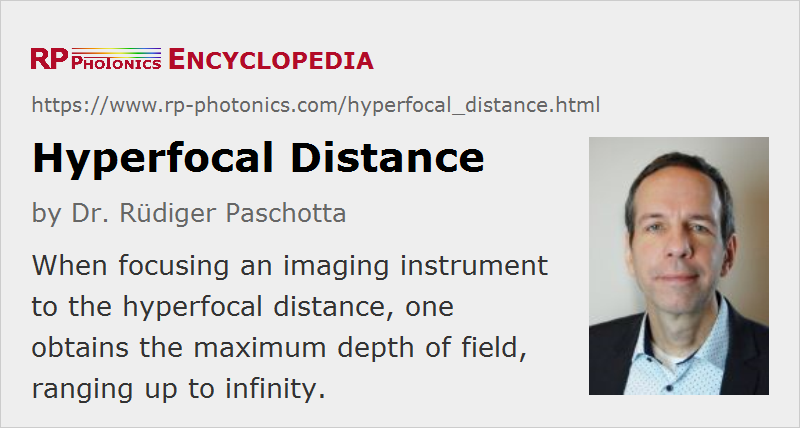Hyperfocal Distance
Definition: the smallest focusing distance of an imaging instruments for which objects at infinity appear with reasonably sharp focus
German: hyperfokale Entfernung
Categories:  general optics,
general optics,  vision, displays and imaging
vision, displays and imaging
Author: Dr. Rüdiger Paschotta
Cite the article using its DOI: https://doi.org/10.61835/7cn
Get citation code: Endnote (RIS) BibTex plain textHTML
Most imaging instruments can provide sharp images only in a limited range of observation distances, as explained in the article on depth of field. The minimum and maximum distance for reasonably sharp imaging both depend on the chosen focusing distance. If the focusing distance is gradually increased, it eventually reaches the hyperfocal distance, where the maximum distance becomes infinity. At this point, the depth of field reaches its maximum possible value for a given size of the aperture stop.
When focusing to infinity, distant objects will be imaged with somewhat better resolution. However, the minimum distance will then be substantially larger.
Some authors use a different definition for the hyperfocal distance: the distance beyond which all objects are reasonably sharp, when the objective is focused at infinity. In practice, this leads to about the same values as with the other definition.
More to Learn
Encyclopedia articles:
Questions and Comments from Users
Here you can submit questions and comments. As far as they get accepted by the author, they will appear above this paragraph together with the author’s answer. The author will decide on acceptance based on certain criteria. Essentially, the issue must be of sufficiently broad interest.
Please do not enter personal data here; we would otherwise delete it soon. (See also our privacy declaration.) If you wish to receive personal feedback or consultancy from the author, please contact him, e.g. via e-mail.
By submitting the information, you give your consent to the potential publication of your inputs on our website according to our rules. (If you later retract your consent, we will delete those inputs.) As your inputs are first reviewed by the author, they may be published with some delay.


Connect and share this with your network:
Follow our specific LinkedIn pages for more insights and updates: